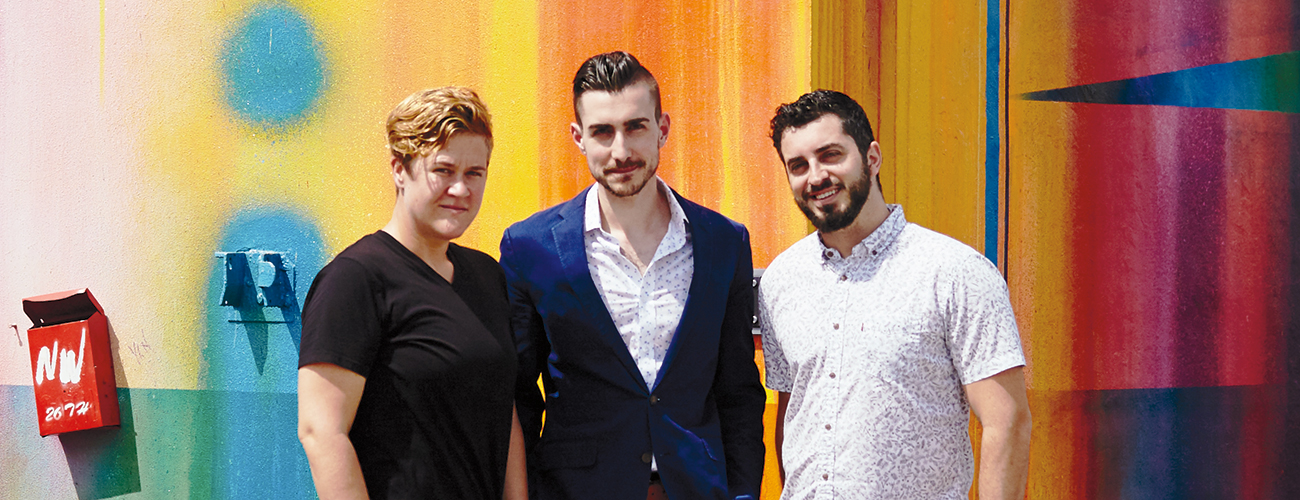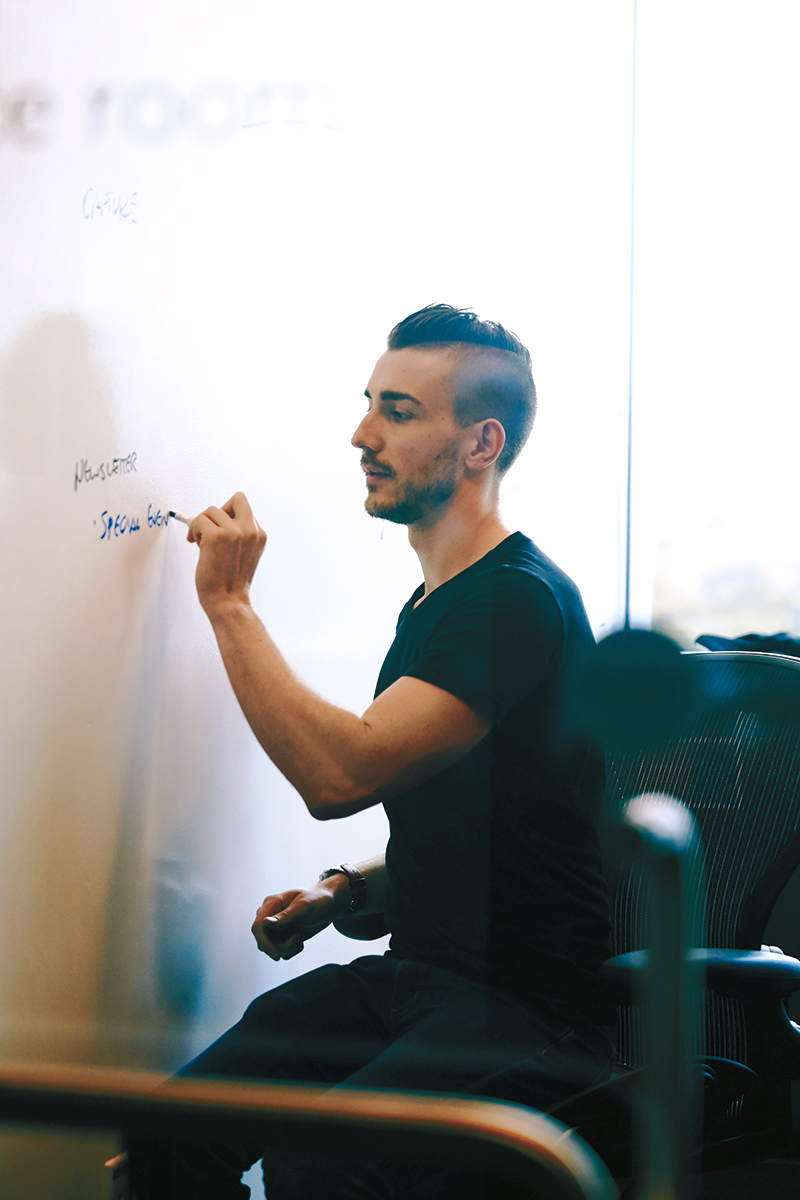Sign up for the daily CJR newsletter.
It is because local journalism needs reinvention that, not long ago, an opera singer stood at the front of a carpeted, fluorescent-lit conference room in a Miami office building belting out a bit of Rigoletto. This was toward the end of the evening, following performances by a pop singer, a spoken-word poet, and an experimental dancer who’d ripped up a sheet of music notation and stuffed the pieces in her mouth. The event’s organizers encouraged the audience of a few dozen people to record the performances. A couple of phones were pointed forward, but most people just sat and watched. Someone’s son played a game on his phone. A woman scarfed a take-out salad. In the back, a pair of roots musicians from Little Haiti, who’d been invited by an acquaintance, expressed mild confusion: What, exactly, was going on here?
Chris Sopher, the 28-year-old behind the event, has a name for it: “experiential local media.” He’s the CEO of The New Tropic, a two-year-old Miami publication whose business model depends largely on producing nontraditional projects such as this event and getting people to take notice. This get-together, developed with a local orchestral school called the New World Symphony, was meant to promote a production called Project 305—305 being a Miami area code—that encourages Miamians to submit footage of the city that the symphony will incorporate into a piece; it was one of several marketing projects Sopher was undertaking for the New World Symphony. The New Tropic had also advertised the event on its website, in its email newsletter, and on its social media feeds. This is all a learning process, Sopher says. Sometimes it goes according to plan, sometimes not. But tonight, people from all over this big, strange, ever-changing metropolis had come together and felt more connected with one another. And for Chris Sopher, that is good for business.
Sopher is one of the principals in an ambitious two-year-old experiment in local journalism that has gone largely unnoticed in wider, New York-centric media circles. In 2015, three similar projects got started within months of one another. They are aimed at drawing in millennials and other curious, socially active people living in cities through online publications that come largely in the form of chatty email newsletters and social media posts, in addition to the requisite websites. Sopher launched a local-media startup called WhereBy.Us whose first publication was The New Tropic. Like the others, it produces a mix of local and entertainment news and links to traditional newspapers. Around the same time, Jim Brady, a newspaper veteran who once ran WashingtonPost.com, launched Billy Penn, a website and newsletter in Philadelphia. His company, Spirited Media, later added a Pittsburgh publication called The Incline. An executive at The Charlotte Observer, Ted Williams, quit his job as the director of digital strategy to open a competing online publication called Charlotte Agenda. A year later, in 2016, three newspaper veterans, including Gordon Crovitz, a former Wall Street Journal publisher, launched Denverite, a website and newsletter featuring local news and event listings in Denver. (“Even if you are very upset over a parking ticket, it is not advisable to write ‘Fuck DPD’ on a cardboard box and park it by an elementary school,” said a link to a news story.)
It occurred to me that Sopher’s stylishness, rather than being an affectation, is crucial to his business plan.
Now, several of those entrepreneurs are becoming more ambitious, quietly taking the first steps to create networks of similar products across the US, as Gannett and McClatchy did with newspapers. Last fall, Sopher opened the second WhereBy.Us online publication, The Evergrey in Seattle, and in March Brady’s Spirited Media announced that it is merging with Denverite’s parent. Brady is taking charge of the combined company, which will keep the Spirited Media name. Both Sopher and Brady say they hope to expand to dozens of cities, with the first several in the next couple of years. These companies’ business models are related but not the same: While Brady focuses largely on events, most of WhereBy.Us’s revenue comes from selling customized marketing packages that might feature a combination of market research, events, and advertising, including various forms of sponsored content. What will turn out to be the most viable business model for this kind of local journalism remains a tantalizingly open question.
ICYMI: Help us track job losses in local newsrooms
Among those trying to answer it, Sopher is both the most ambitious and the least experienced. He was born and raised outside of Washington, DC, and went to college at the University of North Carolina at Chapel Hill, but he presents, aesthetically, as a full-on Miamian. In his Twitter profile photo, his hair is gelled into a swoosh, and he wears big plastic-framed sunglasses and a fitted T-shirt. After the Project 305 event, we went out to dinner at a sleek restaurant in the upscale hipster neighborhood of Wynwood. It occurred to me that Sopher’s stylishness, rather than being an affectation, is crucial to his business plan. He and his colleagues are trying to persuade clients that they know the most influential Miamians. “We’re not a BuzzFeed-scale company,” Sopher says. “If you want to reach the most people in Miami, you should buy ads on Facebook.” His pitch is different: He’ll get you access to the best people.
Sopher told me that The New Tropic and The Evergrey are demographic-agnostic: “We don’t think about our audience as millennials, we think about it behaviorally.” Still, there’s an unmistakable just-out-of-college vibe. The newsletter’s subject line tends to include an emoji—recently, a smiley face wearing sunglasses and the text “305 till I di3.” The New Tropic and its counterparts in other cities are generally more casual, conversational, and irreverent in voice than traditional newspapers (Billy Penn once live-tweeted Governor Tom Wolf’s inaugural address using emojis), and they distribute their content through nontraditional media (Denverite’s journalists started posting on Instagram before they even had a website or Facebook page). People at New Tropic-produced events I checked out included young artists, entrepreneurs, and other miscellaneous millennials. Several said they read and enjoy The New Tropic newsletter. One of my Uber drivers, a Haitian-American who was trying to make it as a musician and a tech entrepreneur, told me he subscribes to The New Tropic newsletter, which helps him feel connected to the Miami scene. “I have a billion-dollar dream,” he told me. “Music won’t make you a billionaire. Meeting people and making connections make you a billionaire.”
The morning after our dinner, I met up with Sopher at his office, in the same building where the event had been held the previous night. Rebekah Monson, the vice president of product and a co-founder, was planning a trip to The Wizarding World of Harry Potter with her niece and nephew, and everyone got to talking about which House they’d live in at Hogwarts. “Which one would I be?” said Sopher, who’d never read the series. “Slytherin all the way,” Monson said. “I thought Slytherins were evil,” Sopher protested. Monson told him they were just cunning and competitive. Those aren’t bad traits in a tough business like local newsgathering. Before the internet came along, people who consumed their daily news in a readable form relied on their hometown newspapers, and companies that wanted to reach these readers used newspaper advertising to do so. Facebook and Google gave readers cheaper, easier access to information and provided local advertisers with cheaper, easier access to those people. And yet, even as the number of journalists at local papers has shrunk at an alarming rate, there remains a hunger for local information, notably in certain fast-growing cities with increasing proportions of young people (i.e., advertising targets).
Sopher told me, “We see companies saying, ‘How do I have a presence that’s meaningful in growing cities that are new destinations?’ ” The thinking behind ventures like his is that if you can avoid the biggest liabilities of local newspapers —printing the physical paper and relying on dwindling display advertising—you might be able to build a decent, or even big, business. “I don’t see a financial way to replace the size and scope of a historical newspaper newsroom, but I don’t know that you really have to,” says Williams, the publisher of Charlotte Agenda.
At this point, the new local publications generally have fewer than 20,000 subscribers apiece to their daily email newsletters, compared with circulations upwards of 100,000 at the incumbent local papers. But because their paperless-ness makes expenses much lower, and because they don’t rely on the kinds of ads that depend on high reader numbers, the financial math can work. Gordon Borrell, a media analyst, summed up the situation like this: “The model of putting local news online is troublesome”—it costs too much and doesn’t generate enough revenue—“except for the fact that it does generate an audience that you can do other things with.”
At Spirited Media, Brady brings in some revenue from ads, but most from hosting exclusive events paid for by sponsors. The publication might write an article about the most successful young lawyers in the city, for example, then host a happy hour for those lawyers and other local notables, sponsored by a law firm. Charlotte Agenda has signed up a small number of local brands—27 at last count—to act as year-round sponsors that advertise on the publication’s website and in its newsletter, but also in less conventional places like its popular Instagram feed, where it might, on behalf of a client, post a picture of a dish from a new restaurant.
Though about 40 percent of WhereBy.Us’s revenue comes from ads that are sold through an automated platform and run in the newsletter, “traditional advertising is not the way of the future,” Sopher told me. The rest of his revenue is generated by market research and campaigns for clients. Monson, the vice president of product, told me about a campaign for Lyft. Monson compiled a list of The New Tropic readers who’d shared transit-related stories on social media and attended New Tropic events on the subject. Her colleagues then invited those people to attend a get-together about transit in Miami. “Facebook and Google are eating everyone’s lunch,” Monson told me. “I don’t think we’re going to be able to win that back. But there’s another layer we can build.”
Sopher’s path to media entrepreneurship was unconventional. In college, he started working on a thesis about millennials’ media-consumption habits, then ditched the thesis and turned his research into an online presentation. The presentation became a kind of calling card: Media organizations around the country started inviting him to give talks on millennials so often that after graduation he was able to build a consulting business. The John S. and James L. Knight Foundation heard about him and, in 2012, hired him to help manage grants and investments in media innovation out of its Miami headquarters. While at the Knight Foundation, Sopher started working with Monson and a friend named Bruce Pinchbeck to organize free local events around civic-engagement themes: “I was bored in Miami,” he says, “and was interested in how you connect people. It was a side hustle in my free time.” Like a lot of warm, vibrant cities in the US, Miami was, and still is, experiencing rapid growth. It is the 12th-fastest-growing city in the US, by population. Sopher thought Miamians needed a better source of information to feel oriented. In 2014, he quit the Knight Foundation to launch WhereBy.Us with Monson and Pinchbeck, helped by a $250,000 investment from the foundation. Sopher sees an appetite for community among people living in Miami and similar cities: “To the extent that newspapers lost their way,” he told me, “what they lost is that.”
The journalist who produces much of The New Tropic’s editorial content is a 26-year-old Florida native, Roshan Nebhrajani, who graduated in 2013 from the Medill school of journalism at Northwestern. This is her first reporting job, and it requires her to be mind-bogglingly versatile. At The New Tropic office, I found her creating a compilation, set to music, of video clips readers had sent in. “I’m just dragging and dropping and making sure it doesn’t look insane,” she explained. Most of Nebhrajani’s afternoons also involve putting together the daily newsletter. (This was a Friday, and she wouldn’t compile Monday’s newsletter until Sunday.) In addition, she usually writes anywhere from two to four articles a week for The New Tropic’s website. After Moonlight, set in Miami’s Liberty City neighborhood in the ’80s, won the Oscar for Best Picture, she wrote about the neighborhood’s history.
We don’t want people to waste their time with anecdotal leads and transitions.”
The New Tropic’s motto, displayed at the top of the website and the newsletter, is “Live like you live here.” Most of its original editorial content tends toward light, delightful features that can be quickly, cheaply produced and make Miamians feel more connected with their surroundings. Investigative reporting, or even covering City Hall, is too resource-intensive, so The New Tropic links to the Miami Herald and other local publications for that kind of news. Ariel Zirulnick, who went to college with Sopher and later worked as a foreign correspondent for the Christian Science Monitor, is the executive editor. She says that in the future she’d prefer to run fewer text stories: “We don’t want people to waste their time with anecdotal leads and transitions.” Zirulnick loves long-form features. But as she and Sopher see it, The New Tropic’s light editorial content does enough to serve their readers and establish their Miami cred. This isn’t to suggest Sopher sees dogged local investigative and beat reporting as obsolete: “Newspapers are some of the only ones doing that in our cities,” he told me. “They must survive, and I’m terrified they won’t survive.”
ICYMI: Tracking Trump-era assault on press norms
Some of Zirulnick’s time is spent on editorial content paid for by sponsors, like an ongoing series on financial insecurity commissioned by Citibank called the Prosperity Project. Zirulnick says she doesn’t see a conflict of interest because, after commissioning a topic, the sponsors “don’t come in and interfere with editorial” and because The New Tropic chooses sponsored projects that align with the editorial mission, such as an ongoing newsletter for entrepreneurs, sponsored by the Knight Foundation. The New Tropic also produces branded content that clients do help craft, which is separately handled by non-editorial staffers. It is the site’s practice to identify both sponsored editorial projects and branded content. On The New Tropic’s social media feeds, material promoting paid clients occasionally hasn’t been identified as such; Sopher says these incidents were mistakes and that The New Tropic is working to make its ethics policies more consistent.
Nebhrajani and Zirulnick are the only editorial employees at The New Tropic; Nebhrajani will soon be leaving to attend medical school, and Sopher is seeking her replacement. (The Evergrey, in Seattle, has an editor and a business head who came up with the idea for the publication; one of them attended college with Sopher and Zirulnick and contacted them early on about working under the WhereBy.Us umbrella.) Three people have tech roles, and eight are in business or administrative roles. Brady’s Spirited Media employs five to 10 journalists in each of its cities, far more than The New Tropic, partly because it relies more on display advertising—which needs high numbers of visitors to be successful—but also because Brady feels that covering big stories makes his publications seem authoritative: “I do think it’s important that you do things that people notice and show that you’re serious about being a real news organization in the city,” he says. Recently, Billy Penn had a scoop on a delay in the reopening of the Philadelphia park that houses Robert Indiana’s “Love” sculpture. Spirited Media sometimes blurs the lines between business and editorial projects—the sponsored parties are based on articles written by editorial staffers identifying the most exciting people in a given field—but when I asked Brady about The New Tropic’s sponsored projects, he told me, “I don’t want to crap on it because I don’t know enough to do that, but it’s never been a model that we’ve chased.”

Bruce Pinchbeck and Roshan Nebhrajani, who produces much of The New Tropic’s editorial content. (Photo by Devin Christopher)
Sopher and Brady agree, however, that expanding to more cities will be important—even crucial—to making their businesses successful. Their companies’ financial performance, and that of Charlotte Agenda, are modest: They each have revenue in the mid- to high six figures, though they expect to reach $1 million in the next few years. While Charlotte Agenda was profitable last year, Spirited Media and WhereBy.Us were not. (In the first quarter of this year, WhereBy.Us was profitable.) Crovitz, the Denverite co-founder, who now sits on Spirited Media’s board, says, “Our thesis is that, in digital publishing, scale is incredibly important.” One benefit comes from distributing certain costs (business, administrative, tech) over multiple cities. The companies also hope to pitch themselves to national brands as local experts.
Sopher believes he can especially reap the benefits of scale if he can create a platform to automate more of what his employees do manually. Take the Lyft campaign. Creating a guest list for the company’s event would have been easier if Monson could have run a software program to identify New Tropic readers and other local people who had attended transportation events and clicked on related stories. Monson told me, “You’re catching us literally in the middle of scoping how all of this could work.” The idea, though, is for the platform, among other things, to be able to automatically create lists of Miamians who could be targeted for event invitation lists or ads based on things like which New Tropic stories they’d shared or read or which events they’d attended. Whether his firm can successfully build this platform, Sopher told me, “is going to make or break our business.”
Sopher and Brady acknowledge that it’s impossible to predict whether their theories will bear out in practice. While their early experiences have been encouraging, Ted Williams, of Charlotte Agenda, presents a cautionary tale. Last year, he opened a second publication, Raleigh Agenda, but shuttered it after four months; his business operation in Charlotte couldn’t build a significant enough advertising business in Raleigh. “I’ve become convinced that the key to financial success for an organization like ours is providing a high degree of advertiser customization and customer service,” Williams says. That suggests that while single local publications can thrive, the business doesn’t scale well. “The only big, scalable winners in local media are and will continue to be Facebook and Google,” he says. “Of course, all of this can change. Media changes fast.”
If anything is certain in local journalism, it is the speed of change. At The New Tropic, I was struck by how little the operation had in common with any other local newsroom I’d visited. As I was leaving, I asked Nebhrajani what she was working on. “I’m going to make a meme,” she told me, “and then maybe start reporting on this story that’s due next week.” She showed me a picture that Denny’s—yes, the breakfast place—had tweeted, involving a stack of pancakes that had gone viral. “I’m going to make something like that,” she explained, “but maybe with a flamingo or a manatee—something real Florida.”
TRENDING: We tested paywalls at NYTimes, WSJ& WashPo and more. All of them were pretty leaky, except one.
Has America ever needed a media defender more than now? Help us by joining CJR today.









